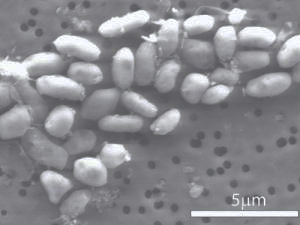“We describe a bacterium, strain GFAJ-1 of the Halomonadaceae family, isolated from Mono Lake, California, which substitutes arsenic for phosphorus to sustain its growth. Our data show evidence for arsenate in macromolecules that normally contain phosphate, most notably nucleic acids and proteins. Exchange of one of the major bioelements may have profound evolutionary and geochemical significance.”
- Felisa Wolfe-Simon, Ph.D., Biochemist, USGS; NASA Astrobiology Institute


Updated December 3, 2010 Washington, D. C. - Today NASA held a much-awaited astrobiology press conference at its headquarters in Washington, D. C. But instead of announcing that Mars has bacteria or watery moon Europa has marine life, the scientists reported finding an Earth-based bacteria called “GFAJ-1” of the Halomonadaceae family in Mono Lake, California, that thrives on arsenic that would ordinarily poison and kill any multicellular life on this planet. In fact, arsenic is used to produce pesticides, herbicides and insecticides because it is so toxic. This is the first form of life known to be capable of growth in environments with little or no phosphorus.
Click here to subscribe and get instant access to read this report.
Click here to check your existing subscription status.
Existing members, login below:
© 1998 - 2024 by Linda Moulton Howe.
All Rights Reserved.

